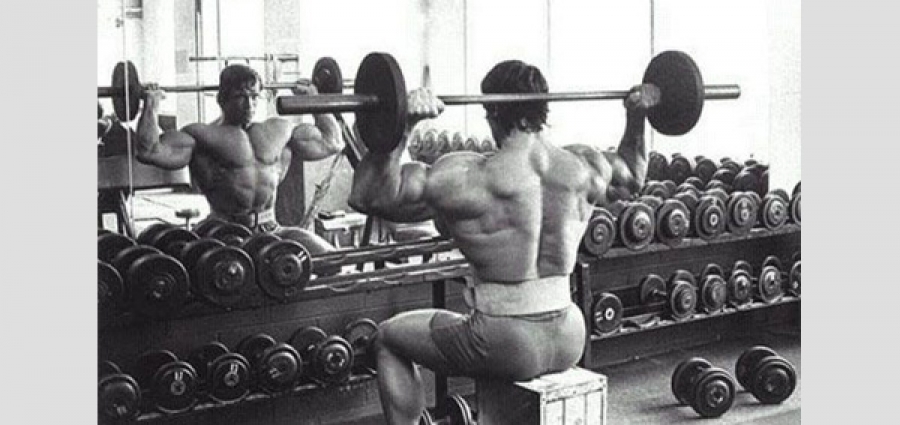Behind the head shoulder press - this is an excellent basic exercise for building powerful deltoid muscles, developing their strength and muscle mass.
Like the standing barbell press, the overhead press is considered one of the most effective exercises for building strength and mass in the deltoid muscles.
Contents
Working muscles:
It pumps the middle bundle of the delts to the maximum, but the front and rear bundles also get their load. It is advisable to perform it at the beginning of shoulder training.
But perform this movement with caution and moderate weights. If you have violation of technique and also painful sensations in shoulders, which do not pass for a long time, decrease working weight.
The barbell press from behind the head will put the necessary stress on shoulders and effectively stimulate the growth of strength and mass of shoulders. All three delta bundles are engaged in this exercise, but the front and middle bundles are loaded the most. In this exercise, the main work is performed by the middle delta and the supraspinous muscle, which is not sufficiently developed in most people.
It is this fact that many sports physicians appeal to when they recommend not to overuse barbell presses from behind the head because the risk of overloading supraspinous muscles and earning a shoulder joint injury in this exercise is very high.
There are at least two variants of the exercise, standing and sitting. The standing variant is considered more for advanced athletes, for beginners, as well as for those who have problems with the back, the sitting variant with a rest on the back is recommended. Also a lighter variant of performing in a sit-in Smith trainer.
The technique of the Behind the head shoulder press in a standing position
- You can take the bar from the floor, but it is most convenient to do it from the racks. Raise the racks, to the level of the middle of the chest, placing a barbell on them. Grasp the barbell with a medium grip and take it to your chest so that it touches the upper chest, legs shoulder-width apart, the back is slightly arched at the waist, the shoulders are straightened, the chest is deployed, the back muscles and abs are tense, and the gaze is directed strictly in front of you. This starting position.
- Inhale, hold your breath and start lifting the bar up. Make sure that the elbows "look" away from the body. At the top of the movement, the arms are fully extended and the bar is above the head. We perform the movement solely due to the shoulders and triceps, do not push the barbell with the force of the body.
- At the top point, pause and tighten your shoulder muscles even more, then, as you exhale, slowly lower the barbell behind your head, without touching your back with the bar until the end of the set.
- Complete the required number of repetitions.
Lowering the neck as far down as possible, you additionally use the top of the trapezium. If you lower the bar to the level of the earlobes or the middle of the back of the head (your shoulders will be on the same straight line), only deltoids work, but you should not lower the bar too deep down.
During the set, keep your chin parallel to the floor and do not turn your head to the sides, otherwise you risk losing balance and tipping over.
Do not lower the bar until it touches the back, the range of motion in this case will be maximum, but in the lower position you overload the shoulder joints too much. Some athletes generally put the barbell on their shoulders to make it easier, of course, this cannot be done.
When performing the exercise, in no case do not relax the press and back muscles. Since they are responsible for maintaining balance and keeping the spine in the correct, S-shaped position. Otherwise, the exercise becomes traumatic for the spine.
When doing presses from behind the head, in addition to the middle and front bundles of the deltas, the supraspinatus muscle is also actively involved, which in most people is not sufficiently developed. Therefore, there is a risk of overloading it and earning a shoulder joint injury.
Bench press from behind the head in a sitting position
This version of the exercise reduces the load on the muscles of the back, as well as the muscles responsible for maintaining the body in balance. With this option, it is also possible to perform in the Smith simulator, for beginners this will be optimal.
Sit on a flat bench or a bench with a back. The loin is slightly bent forward. The legs are spread apart and in contact with the floor. We take the neck of the bar a little wider than the shoulders. Remove the bar from the racks or from the hooks of the machine.
On inspiration, with a powerful effort of the deltoid muscles, we squeeze the bar up, exhaling.
Then slowly lower the bar down behind your head until your elbows are level with your shoulder joint or a little lower. Perform by analogy the planned number of repetitions.
Conclusions
Perform the barbell press from behind your head at the beginning of your deltoid training. Watch your technique and increase the weight gradually. Alternate between standing and sitting.
Useful Links
https://www.youtube.com/watch?v=YbVy_iP1u4I



